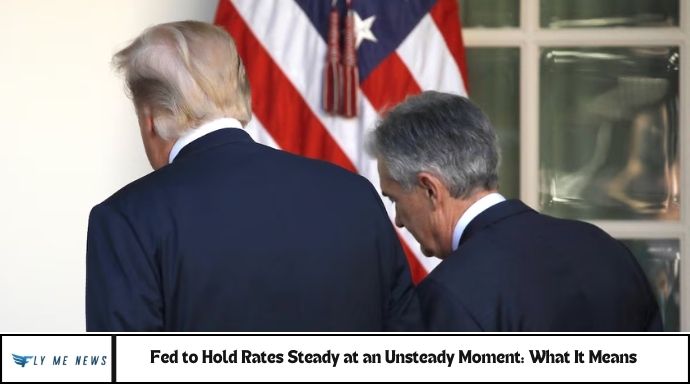Fed to Hold Rates Steady at an Unsteady Moment WASHINGTON, Jan 24 – U.S. Federal Reserve policymakers are expected to hold interest rates steady in their upcoming meeting. However, the bigger story will be how the central bank responds to early actions by President Donald Trump that are likely to influence the economy this year. These include his calls for the Fed to lower borrowing costs further. Trump’s policies, such as restricting immigration and raising import taxes, have already made the Fed’s task more challenging, and on Thursday, he told global business leaders that he would push the Fed to cut interest rates.
Fed to hold rates steady at an unsteady moment In times of economic instability, the Federal Reserve’s decisions can make all the difference. So, why has the Fed chosen to hold interest rates steady at this unsteady moment? With inflation remaining stubbornly high, a slowing economy, and financial markets reacting to global uncertainties, many were expecting a rate hike or a cut. Instead, the Fed has opted for a steady approach, signaling its cautious stance in navigating the current economic turbulence. This article will break down what this means for the economy, financial markets, and consumers.
What Does Holding Rates Steady Mean for the Economy?
The Federal Reserve’s decision to keep interest rates unchanged can have far-reaching effects. The Fed controls short-term borrowing rates, which in turn affect loans, mortgages, and savings accounts. Keeping rates steady signals that the central bank is balancing multiple concerns:
- Inflation concerns: The Fed wants to avoid further accelerating inflation while trying to bring it down.
- Economic growth: A rate hike could slow the economy, while a rate cut could fuel inflation further.
- Global risks: With financial uncertainty abroad, the Fed may be wary of making drastic changes to policy.
By maintaining the current rate, the Fed is trying to provide stability amid ongoing economic volatility.
Impact on Consumers and Borrowers
For everyday consumers, the Fed’s decision could have a mixed impact:
- Mortgages and loans: Rates on new mortgages, car loans, and credit cards will likely stay in their current range. This gives borrowers more time to lock in favorable rates but also means inflationary pressures on everyday expenses may persist.
- Savings accounts: While the Fed’s rate decision won’t immediately boost savings account interest rates, individuals may see more stability in their financial planning.
As inflation continues to affect prices on goods and services, the Fed is trying to strike a balance between offering relief to borrowers while preventing further price hikes.
The Fed’s Dilemma: Inflation vs. Economic Growth
The Federal Reserve is facing a challenging balancing act. On one hand, it wants to curb inflation by raising interest rates, which would typically reduce spending and slow economic growth. On the other hand, excessive rate hikes could push the economy into a deeper slowdown or even a recession.
Currently, inflation remains elevated at around 3.7%, above the Fed’s target of 2%, despite recent rate hikes. But there’s also slow economic growth, making a more aggressive policy move risky. Holding rates steady might signal the Fed’s recognition that the economy needs more time to stabilize before further action is taken.
Financial Markets: Reacting to Fed’s Decision
Financial markets often react swiftly to the Fed’s decisions. Investors and analysts are closely watching the Fed’s moves, as they signal the central bank’s outlook on the economy. By holding rates steady:
- Stock market: The decision could provide temporary relief to equity markets, as investors prefer certainty over unpredictability.
- Bond market: Bond yields may remain relatively stable, but market volatility could still cause fluctuations.
The Fed’s choice to remain cautious may indicate it expects economic growth to slow down in the coming months, making major market swings less likely in the short term.
What Comes Next for the Fed?
The Federal Reserve’s next steps will depend on how the economy performs in the coming months. Key data points like inflation numbers, consumer spending, and GDP growth will guide future decisions. If inflation remains sticky or continues to rise, the Fed might opt for further rate hikes in the future. Conversely, if growth slows significantly, it could take steps to stimulate the economy through cuts or other policy measures.
In the short term, the decision to keep rates steady might be an attempt to “wait and see,” allowing policymakers to gather more data before committing to a more significant action.
FAQs:
Why is the Fed holding interest rates steady?
The Fed is maintaining steady rates to balance inflation control with economic growth amid ongoing global and domestic uncertainties.
How does this affect my mortgage and loan rates?
Mortgage and loan rates are likely to remain steady, offering some stability for borrowers but not offering relief from high inflation.
What’s the current inflation rate?
Inflation is currently at 3.7%, which is above the Fed’s target of 2%, prompting the central bank to hold rates steady.
Will the stock market benefit from the Fed’s decision?
The stock market may experience short-term relief due to the Fed’s cautious approach, as it provides more certainty.
How do interest rates impact the economy?
Interest rates influence borrowing costs, consumer spending, and investments. Rate hikes typically slow the economy, while cuts may encourage spending but drive inflation.
What could the Fed do next if the economy worsens?
If inflation doesn’t decrease or the economy slows further, the Fed could consider rate cuts or other measures to support growth.
Conclusion
The Fed’s decision to hold rates steady at this unsteady moment highlights its cautious approach to the U.S. economy. As inflation persists and growth slows, the central bank is looking to avoid drastic actions that could hurt consumers or investors. However, the future remains uncertain, and the Fed’s next steps will depend heavily on upcoming economic data. For now, the steady rate may offer temporary relief, but the road ahead remains challenging.

